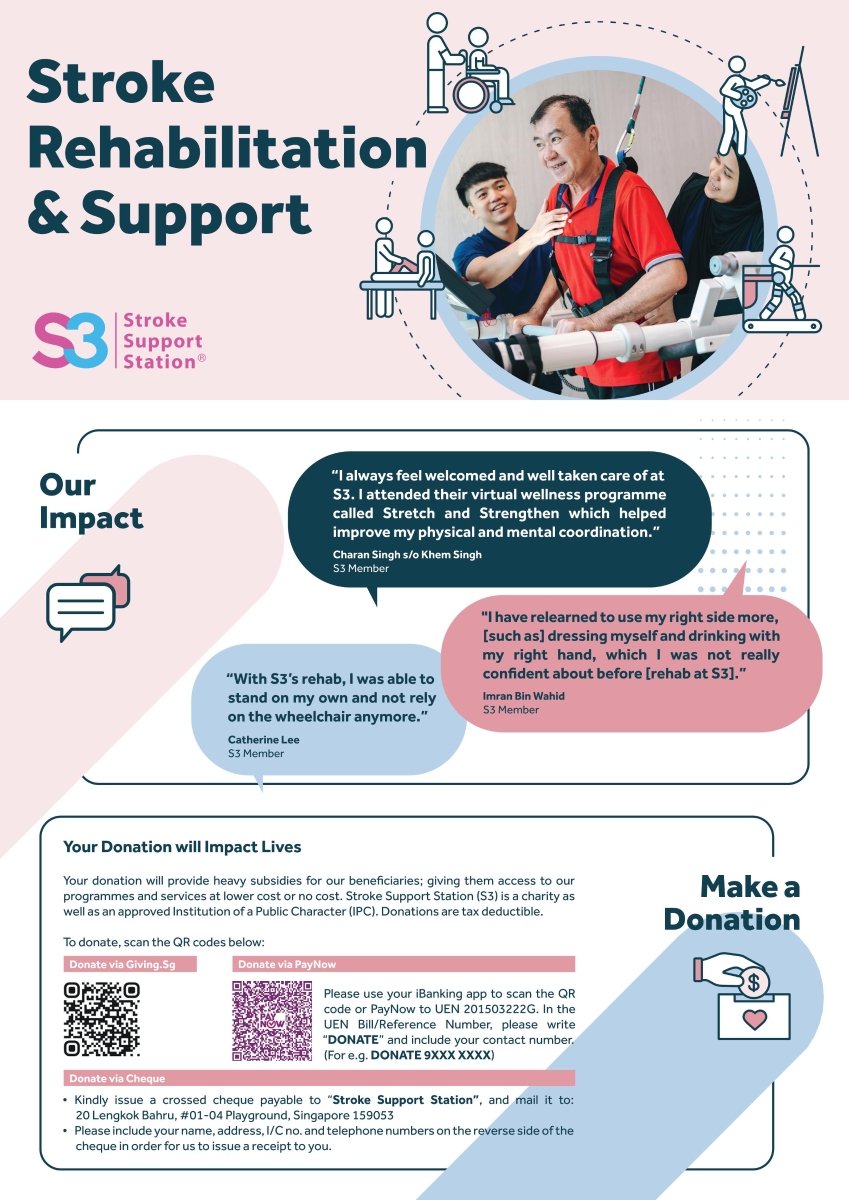For Stroke Survivors and Caregivers
Helping stroke survivors to lead an active lifestyle
We have relaunched our wellness programmes in our Enabling Village and Jurong Point centres! After several months of wellness sessions conducted virtually, stroke survivors and caregivers are happy to be back.
"I enjoy talking to my friends. Doing these activities together with them motivates me to work harder."
Participants in our sessions share the same thought. The face to face interactions allow stroke survivors and caregivers to connect better with each other. Stroke survivors can build social bonds which they rely on in their recovery journey.
Let's look at the various wellness programmes in our centres:
Terrarium Workshop
The magnificent beauty of Gardens by the Bay is first created with a single sappling. Participants got a taste of being a gardener for a day as they create their very own terrarium. Careful attention to details is key to great gardening!
After a stroke, survivors may not be able to move well. They may even suffer from depression and anxiety. Making a terrarium is one of the ways that stroke survivors can gain exposure to greenery, especially if they cannot leave their house. Tending to plants also help them to boost their mood.

Why can't you grow a cactus together with plants like Ivy and Fittonia? Uncle Tony, the instructor taught many interesting knowledge and tips about house plants.
There are three basic steps to create a terrarium:
- Laying the pebbles, moss and topsoil as the foundation of the terrarium.
- Putting in the plants.
- Decorating the terrarium.

Participants spreading the soil evenly to cover the roots of the Fittonia plant. This step is important to maintain the plant's stability.


We would like to thank Uncle Tony's Garden and volunteers from Thye Hua Kwan Aviators (Boon Lay) for supporting this session.
Group Music Therapy
"Love is friendship set to music." - Jackson Pollock, famous American painter
Have you played in a band before? Then you will know that music unites us. When we recognise and share a common love for certain songs, we will talk about it. From these interactions, social bonds are formed.


Stroke survivors playing the bells and tubes instruments
Music does not only involve training the ears. It also trains our hands and brains too! Stroke survivors have to swing the bells to create sounds with strong tone quality. They also train their reaction ability to the signals given by the conductor.

Our beneficiary enjoying the musical songs played.
"I feel really great playing music with my friends. I am able to train my eyes, stimulate my brain and practise moving with my hands. I am better able to focus and pay attention." One of the participants said.
Thank you Association for Music Therapy (Singapore) and Ms Evelyn Lee for your support!
Aerobics

"Don't forget to wear a smile!" Our Aerobics instructor Ms Liew always remind us.
Aerobics combines stretching and strength training exercises which are accompanied by energetic music. During the sessions, Ms Liew taught stroke survivors various exercises such as knee raises, kicks and arm swings. The step exercises are particularly useful to strengthen the knee muscles so that stroke survivors can improve their walking ability.

The lively movements that stroke survivors perform during aerobics improve their endurance and stamina, as well as their cardiovascular health significantly. Ms Liew also encouraged our stroke survivors to remember the sequence of movments to enhance their memory.
Taichi

When you practise Taichi, you are moving like the wind and water. The gentle and fluid movements in Taichi are suitable for stroke survivors with differing levels of functional ability. The calmness of Taichi makes one feel less anxious and depressed.

"Imagine yourself giving a gift to your friend. If your friend does not want it, then you take it back."
"Imagine the sky is falling and you are pushing it back up."
Instructor Edwin uses visualising techniques to help stroke survivors execute the exercises.


Instructor Edwin taught stroke survivors basic Taichi movements such as pushing, pulling and rotation. These movements improve hand mobility. With more strength, stroke survivors can better perform everyday activities such as doing the laundry. Taichi has many more functional benefits such as improving posture, balance and easing pain.
Pastel Nagomi Art
For the third year running, we have partnered with Simply Nagomi to conduct Nagomi art sessions for stroke survivors. Let's take a trip down memory lane.

2019: Simply Nagomi facilitated a Nagomi Art session with stroke survivors in the Istana.View more photos here.

2020: Sessions held in our Enabling Village centre. View more photos here.

"Doing this art is calming." said Mr Liew, one of the participants of the Nagomi Art programme.
Pastel Nagomi Art is a Japanese art form that uses pastel coloured powder to produce soft and gentle art pieces. Firstly, participants sieve the powder from pastel crayons. Then, they rub and dab the powder on a piece of paper. Stencils are used to help stroke survivors create different objects such as birds and flowers. Stroke survivors practise holding, rotating their wrists and controlling their movements.


(A stencil used to etch shapes and objects on a Nagomi art piece)
The soothing pieces of art produced helps stroke survivors to feel relaxed. They also put their memory to the test by visualising and remembering the objects that they have to create.


Downloads







